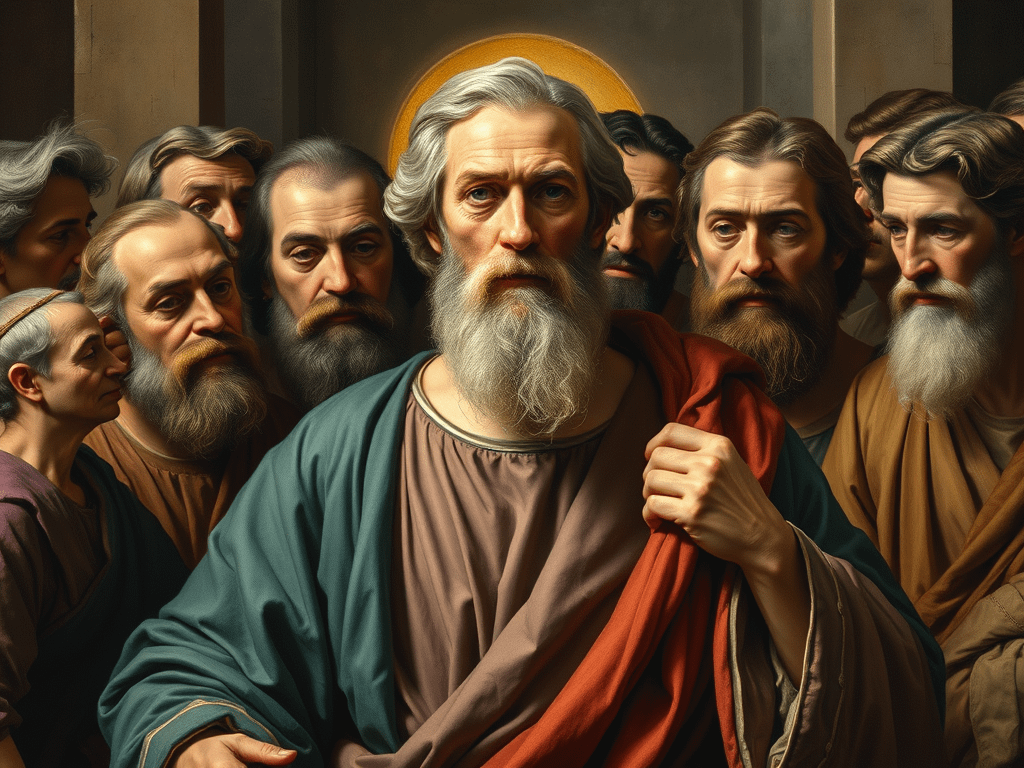Who was Peter in the Bible?
Who was Peter in the Bible? Have you ever wondered why Peter is such a significant figure in the Bible? Often characterized by his impulsiveness and zeal, Peter stands as a profoundly transformative figure in the New Testament.
His story intertwines with some of the New Testament’s most pivotal happenings, serving as a bridge between Jesus’ earthly ministry and the establishment of the early church.
The Early Life of Peter
Peter, originally named Simon, was born in Bethsaida, a town in Galilee. His brother Andrew introduced him to Jesus, and it was Jesus who gave him the name Peter, meaning “rock” in Greek.
This new name symbolically foreshadows Peter’s future role in the early Christian church. As a fisherman by trade, Peter’s encounters with Jesus marked a dramatic turn in his life, leading him from a life centered around the Sea of Galilee to becoming a cornerstone of Jesus’ following.
| Aspect | Detail | Significance |
|---|---|---|
| Birthplace | Bethsaida | Significant fishing town |
| Original Name | Simon | Changed to Peter |
| Profession | Fisherman | Symbolizes humble beginnings |
| Brother | Andrew | First to meet Jesus |
Peter’s Call to Apostleship
Peter’s journey from fisherman to apostle is one filled with remarkable events. One significant moment is when Jesus called him to be a “fisher of men” during a miraculous catch on the Sea of Galilee.
This event is significant as it marked the beginning of Peter’s transition from a simple fisherman to a devoted follower of Christ.
As an apostle, Peter witnessed Jesus’ miracles firsthand and even performed some himself. His close proximity to Jesus provided him with unique insights into Jesus’ teachings, but also highlighted his impulsive nature.
Peter’s transformation does not happen overnight, proving the complex nature of his apostleship. He is seen as a passionate defender of Christ, yet also struggles with doubts and fears.
His human vulnerabilities make his story relatable and inspiring, demonstrating that personal transformation is a journey filled with growth and setbacks.
Peter’s Leadership Among the Apostles
Throughout the Gospels, Peter emerges as a natural leader among the apostles. His leadership is solidified through various acts, such as speaking on behalf of the group and taking initiative in critical moments.
One notable example of his leadership is at the Transfiguration of Jesus, where Peter suggests building three tabernacles to honor Jesus, Moses, and Elijah. Although this idea was mistaken, it demonstrates Peter’s eagerness to take charge and honor significant spiritual moments.
Jesus said to him, “Simon, son of John, do you love me?” Peter was grieved because he said to him the third time, “Do you love me?” and he said to him, “Lord, you know everything; you know that I love you.” Jesus said to him, “Feed my sheep.”
Peter’s leadership is not without error. This is evident in his thrice denial of Jesus, a profound moment that exposed his fears and weaknesses.
Despite this, Peter’s leadership qualities are restored when Jesus, after the resurrection, charges him with the care of his followers, reinforcing the importance of perseverance and redemption in Christian teachings.

Peter’s Role in the Early Church
The Book of Acts showcases Peter’s pivotal role in the early Christian church. After Jesus’ ascension, Peter takes on a more public leadership role, preaching the first sermon on Pentecost, which marks the birth of the church.
His sermon resulted in the conversion of over three thousand people. This key event demonstrated Peter’s ability to inspire and guide believers, affirming his role as a foundational figure in Christianity.
- Peter and John heal a lame man in Jerusalem, causing astonishment and opening discussions about Jesus’ power.
- He delivers a powerful speech before the Sanhedrin, expressing the importance of obeying God over man.
- Peter’s encounter with Cornelius marks a defining moment that illustrates the church’s expansion to Gentile believers.
- His imprisonment and miraculous escape highlight his perseverance and divine protection.
Lessons from Peter’s Life
Peter’s life serves as a profound lesson on the complexities of faith and leadership. His impulsive nature and moments of doubt provide a comforting reminder of human imperfection.
He illustrates how failures and shortcomings are essential parts of spiritual growth and understanding. Despite his initial fears and denials, Peter’s story unfolds into one of redemption, showcasing the transformative power of faith.
Peter’s life teaches Christians about the importance of resilience and redemption. His journey from a flawed but passionate follower to a pivotal leader in the early church mirrors the broader Christian journey of faith, growth, and renewal.
Peter’s Writings and Their Impact
The New Testament includes two epistles attributed to Peter, known as 1 Peter and 2 Peter. These letters offer insights into Peter’s teachings and his efforts to guide early Christians through challenges such as persecution and false teachings.
1 Peter addresses the suffering of Christians and encourages them to endure with hope and faith. It speaks to the trials faced by believers and reassures them of God’s enduring promise.
2 Peter, on the other hand, focuses on warning against false teachings and affirming the truths about Jesus Christ. It serves as an exhortation for believers to remain steadfast in their faith amidst various challenges.
Peter’s Legacy
Peter’s legacy remains profound in both religious and historical contexts. As a key figure in the establishment of the early Christian church, his contributions echo throughout Christian teachings and practices.
The Roman Catholic Church regards him as their first Pope, underscoring his significance in laying the foundations of Christian leadership and his role as a bridge between the Jewish beginnings of Christianity and its unfolding universal appeal.
Peter’s story is a testimony to the power of transformation and dedication to faith, ensuring his place as an enduring symbol of strength, humility, and redemption in Christian history.
Conclusion
Peter’s narrative in the Bible offers a vivid portrayal of faith’s complexities and the power of personal transformation. From his early life as a fisherman to his leadership among the apostles and beyond, Peter’s journey is marked by growth, redemption, and unwavering devotion.
His life story not only illustrates the potential for transformation in all believers but also lays groundwork for the Christian church’s enduring legacy. Through his triumphs and failures, Peter remains a compelling testament to the power of faith and the enduring promise of redemption.
FAQ – Common Questions
What was Peter’s occupation before meeting Jesus?
Peter was a fisherman by trade before he became one of Jesus’ disciples.
Why did Jesus rename Simon to Peter?
Jesus renamed Simon to Peter, which means “rock” in Greek, symbolizing his future role as a foundational leader of the church.
Did Peter have any significant failures?
Yes, Peter famously denied Jesus three times before the crucifixion, a moment that highlighted his fear and need for redemption.
What was a key event Peter experienced with Jesus?
The Transfiguration, where Peter witnessed Jesus in His divine glory alongside Moses and Elijah, is one key event he experienced.
What is the significance of Peter’s letters in the New Testament?
The letters of Peter offer guidance on enduring persecution and emphasize the importance of maintaining true doctrine against false teachings.







